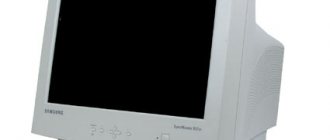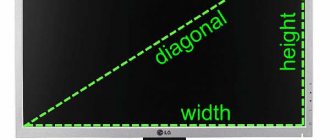A small TV receiver is suitable for the kitchen and small room. Buyers are often interested in how many cm a TV (monitor) is, a 22-inch diagonal, and its dimensions in width and height. Depending on the shape, the screen can have a length of 48.7 cm, or 43.5 or 48.7 centimeters. This is an easy-to-use monitor and compact TV for the kitchen and small room.
Screen resolution
Inches and centimeters
A 22-inch diagonal is 55.88 cm - the main characteristic by which a buyer chooses a TV. The distance between opposite corners is determined by:
- Screen width and height.
- Its resolution.
- Distance to TV when watching programs.
Length converter from centimeters to inches and vice versa.
Finding the screen size diagonally is very convenient. The parameter is universal, available for most simple geometric shapes. Using the diagonal you can determine the dimensions:
- circle;
- square;
- rectangle;
- concave and convex surface.
The first picture tubes had a round convex screen. They were measured in centimeters in any direction. They were replaced by slightly curved monitors with an aspect ratio (length and width) of 4:3.
Inches and cm
They were created for viewing analog television programs. The diagonal of domestic models was approximately 22″, but the technical documentation indicated the size of the TV in cm or inches diagonally.
With the advent of imported television receivers, they switched to an international labeling system. All screens began to be defined in inches. From the diagonal size in inches, we determined the length and width (height) of the screen and TV body in cm.
Soviet standards strictly regulated all dimensions. A regular 22-inch TV had a diagonal of 22″. When rounded to the nearest whole number, the figure was 56 cm - the length of the television receiver body.
In stock
The height was proportional to the aspect ratio of the screen - 42 cm. The width of the housing depended on the kinescope model and gradually decreased. Focusing on these dimensions, the furniture industry produced cabinets and TV tables.
22″ TVs come in the old 4:3 aspect ratio, when the screen was almost square.
With the development of digital technology, picture quality has improved. The length and width (height) of the screen have become popular in the 16:9 ratio.
Where is the diagonal indicated?
Visually determining the size of a television receiver is difficult. We need to find the value of its diagonal.
When choosing equipment in a store, you should pay attention to the full model name.
The diagonal size in inches usually appears after the company name if the screen resolution is not indicated. For example, Philips 22PFS5303, Samsung UE22H5610. Markings are available on the back of the case, on the side of the box and in the technical data sheet.
How to determine other dimensions
In large sales areas, all equipment looks small. It will look different in the room. You should determine in advance which TV size in cm or inches diagonally will fit in the living room and which one will fit in the kitchen.
Monitor in the room
What width and height of a TV screen, computer monitor and laptop is determined by the Pythagorean theorem. More than 25 centuries ago, an ancient scientist discovered the formula for the aspect ratio and hypotenuse in right triangles:
A2 + B2 = C2.
Using this formula, you can calculate what size monitor a laptop or computer has, and what bedside table to buy for the TV.
In inches
The size of the equipment depends on the aspect ratio of the screen. If the TV diagonal is 22″, and the width-to-height ratio is 4:3, then:
- monitor width – 17.6 inches;
- Screen height – 13.2”.
Twenty two inches
This is a size that is widely used for computer monitor and large laptop.
A 22-inch TV (monitor), which receives TV broadcasts in digital format, has an oblong screen with an aspect ratio of 16:9. Its dimensions will be 19.1 x 10.8 inches.
In centimeters
If the size of the TV is 22″, then it is easy to determine how many centimeters it is, and it is not difficult to find out its height and width. One inch by international standards is equal to 2.54 cm. Therefore, a diagonal of 22″ is equal to:
22 × 2.54 = 55.88 cm.
See diagonally
How much width and height are in centimeters can be calculated in different ways. For example, convert the inch value by multiplying by 2.54. Or, using the aspect ratio, calculate using the Pythagorean theorem. According to it, a monitor with an aspect ratio of 4:3 will respectively have dimensions of 43.5x32.6 centimeters.
It is also not difficult to calculate how many cm the parameters of an oblong screen with an aspect ratio of 16:9 will be. They are defined similarly. The results of converting from inches to centimeters and calculating using the formula differ slightly, in decimal places. The value after rounding the numbers is the same:
- length – 48.7 cm;
- height – 27.4 centimeters.
Inches and monitor dimensions
It’s easy to quickly determine the dimensions of a 22″ TV receiver. It is enough to find a conversion table on the Internet and see the size of the monitor, knowing how many centimeters or inches the diagonal is.
Choosing a monitor size based on area of use
Diagonal 42 inches
And now in more detail about what size monitor is best suited for what tasks.
Up to 18 inches
Quite rare modifications that are almost no longer produced today. The scope of application is work and only work, and in those areas where the device is supposed to be used not constantly, but periodically.
For example, in an enterprise warehouse: a storekeeper makes a receipt or write-off of material assets, which takes no more than an hour, and goes on to do other things, of which there are plenty in any warehouse.
In addition, such a monitor can be used by a streamer as an additional one: display a picture from the game on your big cool monitor and broadcast from it, and use a small monitor, for example, to display a chat to communicate with viewers. They say it is also very good for everyone as a whole can monitor donations in real time on such a display: even when a small amount is received, the mood improves. And a good mood is half the success of any stream.
18 to 22 inches
Popular models used mainly for work, mainly in private companies.
Regarding government agencies, one interesting pattern has been noticed: the budget for upgrading the computer park is either not allocated at all, and employees have to use ancient small monitors, or it is allocated in excess and is spent stupidly, so each employee is bought a huge “TV.”
This is not very convenient to work with, and it takes up space on the desktop.
In private companies, where enterprising management counts every ruble, a large monitor can only be placed at the reception - to create an image, and in the admin’s closet, so that it is convenient for him to do his admin duties.
Most employees are provided with monitors of exactly the designated size - it is quite convenient to work with this, and no one will overpay for extra inches. Capitalism, however.
22 to 26 inches
The ideal monitor size for a keen gamer: the picture is clearly visible, without having to turn your head to see what is happening in the corners of the screen. Naturally, if there is slight discomfort, the device can be moved further away or moved closer, depending on the desired effect.
Please note that the minimum recommended distance at which your eyes should be from the display is at least 50 cm.
26 to 32 inches
This diagonal is more suitable for a media center or home theater used for watching movies. It is desirable that such a monitor have a wide viewing angle so that the picture can be seen from anywhere in the room.
Screen distance for comfortable viewing
Image resolution is determined in pixels - image reproduction points per unit area. On large panels, when showing old films and TV programs, you can see blurry contours and a blurry picture.
Distance to TV according to standards
The 22″ monitor is unique, it is suitable for any image reproduction format. At the same time, it is convenient to work at the computer. All pictures and graphics are clearly visible and the content is easy to read.
The image quality of a 22-inch TV depends on the distance to the screen. The question often arises about how many centimeters should be between the device and the chair in order for all analogue and digital TV programs to be clearly perceived without distortion.
The norm is defined as 3 diagonals for DVD transmissions, 2 diagonals for HD screens. The computer reproduces images with Full HD resolution and higher; the distance from the eyes to the monitor is allowed to be 1.2–1.5 diagonal lengths.
Distance standards
A normal 22″ TV should be located no closer than 1.7 meters from the viewer. It is enough to remove the computer monitor 70 cm from the eyes.
The relatively small size of the screen does not allow it to accommodate 4000 pixels. Therefore, 4K resolution screens have significantly larger sizes, starting from 50 inches.
All types of television receivers with a diagonal of 22″ do not exceed 48.7 centimeters in width. This ensures a comfortable viewing experience since there is less than 20 degrees between your eyes and the edges of the screen.
TV receiver height
The image will begin to lose color and clear outlines if it moves more than 10 degrees away from the center. You can comfortably watch TV programs at a distance of 2–2.5 m, sitting directly in front of the screen, or at a distance of 0.5–0.7 m away from the center.
The height at which the monitor is installed is also calculated diagonally. The center of the image should be at eye level of a sitting person - approximately 1 meter from the floor. For 22″ models, the bottom edge of the screen should be at a height of 80–90 cm from the floor.
What to look for when choosing a TV diagonal?
As practice shows, a large TV screen is not always convenient and comfortable. It’s not enough to buy a 102-inch diagonal TV; you need to correctly correlate the size of the display and factors such as:
- room sizes – for small rooms, 19-20-inch monitors are sufficient;
- distance from the screen to the viewer - traditionally, the viewing distance is calculated as 3-4 diagonals of the TV;
- ratio of diagonal to screen resolution - the smaller the diagonal, the lower the resolution and vice versa. If this condition is not met, the picture may disintegrate into individual pixels, which significantly reduces viewing comfort.
Essentially, today there are two options for choosing the optimal screen diagonal. The first is that based on the area of the room, the location of the TV viewer and the operating features (watching news programs, DVD recordings, etc.), the maximum allowable diagonal of the TV is selected. Second, taking into account the desired screen diagonal, the location for installing the TV and the place for viewers is selected. Practice shows that for standard apartments the ideal solution is a TV with a diagonal of 32 - 40 inches.
About sizes in general
All physical dimensions of the screen, be it a computer monitor or a TV, according to standards, are usually measured not in centimeters, but in inches. In pixels, such a parameter as screen resolution, that is, length and height, is measured.
From this article you will learn:
At the same time, these quantities are not correlated (not interconnected) in any way, since the size of the pixel, that is, the elementary point showing the image, can be different. Therefore, there are no adequate tables showing this ratio truthfully: with the same dimensions, monitors may have different ratios.
Today, the optimal screen resolution is 1920x1080, which meets the Full HD broadcast standard. What sizes are there: maybe 19 or even 34 inches, but the most common is a screen with this resolution and a diagonal of 24 inches.
This is exactly the standard that you should focus on when choosing a screen. Read more about monitor aspect ratio here.
Users often have a question: does monitor size affect performance? Only partly, since it primarily depends on the resolution (here you can read in more detail).
This should be taken into account when building a gaming PC: the higher the resolution, the more pixels the video card has to process simultaneously, and the more powerful it must be. On the other hand, large monitors allow you to fully enjoy your favorite game, completely immersing yourself in the virtual world.
Medium and small screens, for example, 21.5 diagonal, are more suitable for work than for entertainment. This is an ideal option for an office or government agency.











